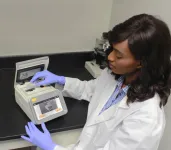(Press-News.org) (Portland - March 15) Results of a clinical study conducted by researchers in Manaus, Brazil, show that the Gazelle® Malaria test outperformed Rapid Diagnostic Tests (RDTs) and was nearly as accurate as more expensive and time-consuming expert microscopy in detecting Plasmodium vivax (P. vivax) malaria. The data was published Friday, March 12 in the Malaria Journal.
The double-blind study was based on 300 participants who sought care from Fundac?a?o de Medicina Tropical Doutor Heitor Vieira Dourado (FMT-HVD), located in Manaus, an area in the Western Brazilian Amazon, heavily endemic for P. vivax.
"Because P. vivax is not adequately detected by current tests, the infection is frequently missed, and patients don't receive essential treatment," said Dr. Marcus Lacerda, Infectious Disease Researcher at FMT-HVD and lead investigator for the study.
"This causes recurrent symptoms and contributes to the spread of the disease. These results shows that we're on a path to reduced suffering and faster malaria elimination."
P. vivax is the second most prevalent malaria species infecting humans and is widespread among many countries seeking to eliminate malaria. Although considered less deadly than P. falciparum (the most common species), P. vivax infections can result in serious illness and mortality.
Additionally, P. vivax presents a special challenge for diagnostics due to its typically low levels of parasitemia. Current RDTs miss many P. vivax infections, thus light microscopy, which is time-consuming and requires skilled technicians, is the current best option for many regions of the world.
Researchers at FMT-HVD noted that the Gazelle Malaria Test's use of hemozoin, a highly specific biomarker present in all species of malaria, shows promise for detecting low parasitemia P. vivax infections.
When compared to optical microscopy in this study, the sensitivity and specificity of the Gazelle test were 96.2% and 100% respectively, whereas for RDTs they were 83.9% and 100%. This equates to RDTs missing 16 cases of P. vivax infection per 100 people, and Gazelle missing only 4.
The researchers also noted that Gazelle's portability, all-day battery operation, and supplies that do not require cold chain, make the device a promising alternative to light microscopy in field conditions.
"This milestone aligns with Hemex's strategy to assist countries with elimination efforts," said Patti White, CEO of Hemex Health. "We fully expect that with Gazelle's affordability, ease-of-use, and ultra-fast results, it can be used successfully for case management, mass and border screenings or during outbreaks."
The company has regulatory approval in a growing number of countries, including India, Kenya, and Ghana, and plans to apply for approval in South America soon.
INFORMATION:
About Gazelle
Gazelle is a compact, rugged, battery-operated diagnostic device. Gazelle can be used inexpensively, with no cold chain requirements by entry level healthcare workers in areas with limited access, resources or electricity. Patient information and results are captured digitally for storage, printing, or later transmission.
Gazelle is approved for detecting malaria and sickle cell disease in a growing list of countries, and integrates miniaturized versions of trusted technologies, innovative optics, and artificial intelligence. This versatile approach allows the company to continually add diseases to its menu of tests and expand to new users. Gazelle is an accurate and rapid digital platform that can work just about anywhere in the world.
With its affordable, compact, and rugged design, and all-day battery power, it delivers powerful, rapid diagnostics to more places without the need for a cold chain-- from remote, low-resource settings, to drive through testing, border crossings, or nursing homes.
About Hemex Health
Hemex Health breaks traditional barriers with its innovative diagnostic system that expands the potential of diagnostics for emerging diseases, making accurate test accessible to new locations and new populations.
Hemex Health designs diagnostic technologies for the real world by listening to the needs of healthcare providers including those in some of the most remote and challenging settings. The Gazelle technology was developed in collaboration with Case Western Reserve University. Hemex Health is located in Portland, Oregon, USA. HemexDx, a subsidiary of Hemex Health, is located in Mumbai, India. More information can be found by going to http://www.hemexhealth.com.
Copper nanomaterials with a cubic shape so perfect that they form neatly aligned stacks when brought together have been created by researchers at KAUST. The cuboid copper nanoclusters, developed by rational design, are a new member of an exotic nanomaterial family that has shown many promising properties but has remained very hard to make.
"Copper nanomaterials are a class of materials that exhibit useful properties for the fields of photoluminescence and catalysis," says Ren-Wu Huang, a postdoc in Osman Bakr's lab, who led the research. There is great interest in synthesizing new copper nanomaterials to understand how their structure influences their function.
Copper nanoclusters, which are of an atomically precise structure, are among the few copper nanomaterials that ...
An interdisciplinary, multinational research team presents a new class of chemical compounds that can be reversibly oxidized and reduced. The compounds known as 'pyrazinacenes' are simple, stable compounds that consist of a series of connected nitrogen-containing carbon rings. They are suitable for applications in electrochemistry or synthesis, as the researchers describe in the science journal Communications Chemistry.
Redox reactions play an important role in our everyday life. In these reactions, one compound releases electrons and is oxidized, while another accepts ...
A discovery by University of Queensland pain researchers may allow some future cancer patients, including children with leukaemia, to avoid their chemotherapy's worst and most debilitating side effects.
Professor Irina Vetter and Dr Hana Starobova thought "turning off" the inflammation that is one of the body's natural reactions to the chemotherapy drug vincristine might reduce its accompanying pain and unpleasant symptoms.
"We found the anti-inflammatory drug anakinra substantially reduced the awful nerve symptoms for which vincristine chemotherapy is known," Professor ...
A study by a research team from Nanyang Technological University, Singapore (NTU Singapore) and China's first digital-only bank WeBank has found that security, service quality and system quality are the most important factors for customers who use mobile banking.
Two in five respondents (40%) said that the security they felt while carrying out transactions on mobile applications was their most important consideration.
This was followed by the level of service quality (25%), which referred to whether the banking applications could fulfil users' needs, such as carrying out transactions and easy access to credit card services.
System quality, which considers the performance of the application, including ...
Researchers at UniSA have developed a cost-effective new technique to monitor soil moisture using a standard digital camera and machine learning technology.
The United Nations predicts that by 2050 many areas of the planet may not have enough fresh water to meet the demands of agriculture if we continue our current patterns of use.
One solution to this global dilemma is the development of more efficient irrigation, central to which is precision monitoring of soil moisture, allowing sensors to guide 'smart' irrigation systems to ensure water is applied at the optimum time and rate.
Current methods for sensing soil moisture are problematic - buried sensors are susceptible to ...
Dr Daniel Montesinos is a Senior Research Fellow at the Australian Tropical Herbarium, at James Cook University in Cairns. He is studying weeds to better understand (among other things) how they might respond to climate change.
He said most invasive plants are characterised by their rapid pace when it comes to taking up nutrients, growing, and reproducing - and they're even faster in the regions they invade.
"New experiments comparing populations from distant regions show a clear trend for already-fast invasive plants to rapidly adapt even faster traits in their non-native regions," Dr Montesinos said.
This is further pronounced in the tropics and sub-tropics.
"Even though invasives' growth rates are already among the highest for plants, when they invade new territory ...
A new concept of on-demand drug delivery system has emerged in which the drugs are automatically released from in vivo medical devices simply by shining light on the skin.
A research team led by Professor Sei Kwang Hahn of the Department of Materials Science and Engineering and Professor Kilwon Cho of the Department of Chemical Engineering at POSTECH have together developed an on-demand drug delivery system (DDS) using an organic photovoltaic cell coated with upconversion nanoparticles. This newly developed DDS allows nanoparticles to convert skin-penetrating near-infrared (NIR) light into visible light so that drug release can be controlled in medical ...
An international team of researchers, affiliated with UNIST has unveiled a novel technology that could improve the learning ability of artificial neural networks (ANNs).
Professor Hongsik Jeong and his research team in the Department of Materials Science and Engineering at UNIST, in collaboration with researchers from Tsinghua University in China, proposed a new learning method to improve the learning ability of ANN chips by challenging its instability.
Artificial neural network chips are capable of mimicking the structural, functional and biological features of human neural networks, and thus have been considered the technology of the future. In this study, the research team demonstrated the effectiveness of the proposed learning method ...
A chromatin-regulating enzyme has been shown by in-depth interdisciplinary investigations to be a key driver of a common type of lung cancer. Drugs that target the enzyme could improve treatment and survival rates for this particular cancer.
"Squamous cell carcinoma represents nearly one third of all lung cancers in humans," says KAUST structural biologist Lukasz Jaremko, who led the research along with colleagues at Stanford University and The University of Texas MD Anderson Cancer Center, U.S. "Our joint structural and dynamics investigations, including enzymatic activity studies, genetic analyses, and mouse model and human cell results, ...
Basic, acidic, basic again: for pathogenic bacteria such as Salmonella, the human digestive tract is a sea change. So how do the bacteria manage to react to these changes? A team of researchers from the Max Planck Institute for Terrestrial Microbiology in Marburg led by Andreas Diepold has now provided a possible explanation: pathogenic bacteria can change components of their injection apparatus on the fly - like changing the tires on a moving car - to enable a rapid response.
Some of the best-known human pathogens - from the plague bacterium Yersinia pestis to the diarrhea pathogen Salmonella - use a tiny hypodermic needle to inject disease-causing ...





